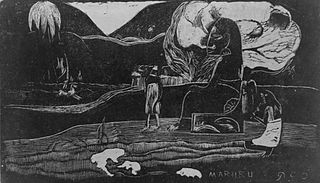Related Research Articles
Māui (Maui) is the great culture hero and trickster in Polynesian mythology. Very rarely was Māui actually worshipped, being less of a deity and more of a folk hero. His origins vary from culture to culture, but many of his main exploits remain relatively similar.

Hina is the name assigned to a number of Polynesian deities. The name Hina usually relates to a powerful female force who has dominion over a specific entity. Some variations of the name Hina include Sina, Hanaiakamalama, and Ina. Even within a single culture, Hina could refer to multiple goddesses and the distinction between the different identities are not always clear. In Hawaiian mythology, the name is usually paired with words which explain or identify the goddess and her power such as Hina-puku-iʻa (Hina-gathering-seafood) the goddess of fishermen, and Hina-ʻopu-hala-koʻa who gave birth to all reef life.
In Hawaiian religion, Hiʻiaka is a daughter of Haumea and Kāne.

Menehune are a mythological race of dwarf people in Hawaiian tradition who are said to live in the deep forests and hidden valleys of the Hawaiian Islands, hidden and far away from human settlements.
In Polynesian mythology, Atonga is a culture hero, half-mortal and half-spirit. He built the first canoe on Savaii with his brothers Olokeu and Olo-i-nano, then had it transported to Upolu by birds.
In Hawaiian mythology, Kalamainu'u was a lizard goddess.
In Hawaiian mythology, ʻAikanaka is a mortal chief who married Lona, the moon goddess. They lived happily together in her palace until he died of old age.

In Māori mythology, Matuku-tangotango (Matuku) is an ogre who kills Wahieroa the son of Tāwhaki. In some versions, Matuku lives in a cave called Putawarenuku. Rātā, the son of Wahieroa, sets off to avenge his murdered father, and arrives at last at Matuku's village. He hears from Matuku's servant that at the new moon his master can be killed at the pool where he washes his face and hair. When the new moon has come, Rātā waits until the ogre comes out of his cave and is leaning over with his head in the pool. He grabs him by the hair and kills him. Rātā then sets off to rescue his father's bones from the Ponaturi. A South Island version names the islands where Matuku lives as Puorunuku and Puororangi and also states that Rātā nooses Matuku as he comes out of his lair to perform certain rituals.
In Hawaiian mythology, Nāmaka appears as a sea goddess in the Pele family. She is an older sister of Pele-honua-mea.
In Hawaiian mythology, Paliuli is the equivalent of the Garden of Eden, a legendary paradise and the home of Princess Laieikawai (Lā'i.e.-i-ka-wai). It was used for several place names, including a sugar mill owned by Henry Perrine Baldwin.

Alyxia stellata, known as maile in Hawaiian, is a species of flowering plant in the dogbane family, Apocynaceae, that is native to Hawaii. It grows as either a twining liana, scandent shrub, or small erect shrub, and is one of the few vines that are endemic to the islands. The binomial nomenclature means "chain resembling olive" in Latin. The leaves are usually ternate, sometimes opposite, and can show both types on the same stem. Flowers are quite inconspicuous and have a sweet and light fragrance of honey. The bark is most fragrant and exudes a slightly sticky, milky sap when punctured, characteristic of the family Apocynaceae. The entire plant contains coumarin, a sweet-smelling compound that is also present in vanilla grass, woodruff and mullein. Fruit are oval and dark purple when ripe. Maile is a morphologically variable plant and the Hawaiian names reflect this.
In the Polynesian mythology of the Tuamotu archipelago in the South Pacific, Puna is the king of Hiti-marama or of Vavau, depending on the story.
In Hawaiian mythology, the Nawao are a legendary people, a wild, large-sized hunting people, descended from Lua-nu'u. Other sources suggest that the Nawao were present in Hawaii before the Menehune who are thought to have driven them out or destroyed them. However, folklorist Katherine Luomala believes that the legends of the Menehune and similar creatures are a post-European contact mythology.
In Hawaiian mythology, Laʻieikawai (Lāʻi.e.-i-ka-wai) and her twin sister Laʻielohelohe were princesses, and were born in Lāʻie, Oʻahu.
In the Tuamotu islands, the telling of the full cycle of the legend of Rata takes several evenings to tell.

In Hawaiian religion, Māui is a culture hero and ancient chief who appears in several different genealogies. In the Kumulipo, he is the son of ʻAkalana and his wife Hina-a-ke-ahi (Hina). This couple has four sons, Māui-mua, Māui-waena, Māui-kiʻikiʻi, and Māui-a-kalana. Māui-a-kalana's wife is named Hinakealohaila, and his son is named Nanamaoa. Māui is one of the Kupua. His name is the same as that of the Hawaiian island Maui, although native tradition holds that it is not named for him directly, but instead named after the son of Hawaii's discoverer.
In Tuamotu mythology, Vahi-vero is the son of the demigod Kui and a goblin woman named Rima-roa.
In Tahitian mythology, Vahieroa is a son of Tafa'i and his wife Hina, and is born at his father's house in the Tapahi hills of Mahina in north Tahiti. He weds Maemae-a-rohi, sister of the ruling chief Tumu-nui.

In Hawaiian mythology, Kū is one of the four great gods. The other three are Kanaloa, Kāne, and Lono. Some feathered god images or akua hulu manu are considered to represent Kū. Kū is worshiped under many names, including Kū-ka-ili-moku, the "Snatcher of Land". Rituals for Kūkaʻilimoku included human sacrifice, which was not part of the worship of other gods.
Kahiko-Lua-Mea is a god in Hawaiian mythology, who was once a chief on the Earth and lived in Olalowaia. He is mentioned in the chant Kumulipo and in the Chant of Kūaliʻi.
References
- M. Beckwith, Hawaiian Mythology (University of Hawaii Press: Honolulu) 1970.